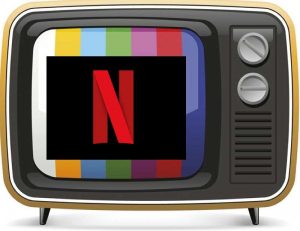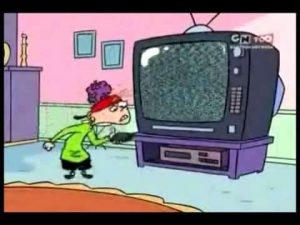In a world of increased professional mobility, which often transplants scholars internationally for various lengths of stay, I have always felt myself at home with television. No matter where I moved – access being less of a problem today than ever before, I found a way to reconnect with what I loved, explore what is new, and understand the culture (and its misrepresentations) with a little help of my screen friends. Always interested in foreign content, I was quite happy when I could follow my Friends (NBC) on DVD while in Germany, access Tatort (ARD) in the Mediathek from US, finish a paper on Jerry Springer, while visiting the Netherlands and find a way to HULU when finally returning to Europe. I am not the most conventional viewer, obviously, I belong(ed) to a few specific niche audiences, the Foreign Program Adopters, TV scholar, diasporic…. I thought I would experience the televisual landscape of the United Kingdom and happily add it to my familiars, my screen-homes, especially considering how much British television I already consumed.
I had set expectations of the transition. Yes, there would be different content, different international trade licenses in place, policies affecting cultural representations, the strong public broadcast institutions creating a different but comprehensible landscape for me. I thought there’d be different uses of existing technologies (DVRs and broadband, satellite etc. I find are quite differently integrated into television industries in various countries). I knew providers would offer different packages, effected by viewing practices and national culture… And yet, I found myself ill prepared and utterly “out-of-place” once sitting down, remote in hand. Television, my “teacher, mother, secret lover (The Simpsons)” had let me down; all the “eliteness” of my viewership profile was rendered useless. The flood of online offerings, the lack of value (seriously, I do not know what I am paying for) in the package deal I made, and the simple existence of aerials (which is what my package deal runs on – seriously), and all the issues that come with that … too much to deal with when transitioning into a busy semester in a new country, in a different academic system.
While starting with this personal perspective, this is something that becomes academically interesting, when I see myself as a specific and general audience member, one that has now realized that she turns to Netflix for comfort, no longer to seek out complex TV, international programming and challenging films, as she once had. I found myself less drawn to those programmes that would make me highly invested in an academic way. Instead, the once novel access and now generally branded as elevated not-TV content have taken on the role the family TV, bulky and loved, once held.
In that regard, and following some discussions as found in Amanda Lotz’ previous works, Netflix very much IS TV, when looking not at the medium but the value system, the configuration, if you so will, it represents, even if we probably are served well in using her more current terminology, addressing both access and content, when thinking about access and exhibition: “portals”. If Netflix is now entering the space of expected, ordinary and familiar media fare, how does this then affect the hierarchies that are connected to the Netflix brand, or the cultural capital provided by hosting complex serial content (see Mittell, Dunleavy), or the audiences’ self-perceptions as “not TV viewers”? For those of us teaching in classrooms and opening our semester with questions like “What TV shows do you like?”, the response: “I do not watch TV” is still a marker of legitimacy issues and cultural capital as it applies to television. Thank you, HBO, your campaign worked well.[1] However, students and others frequently lay open how much “TV” they really watch once you start involving them in conversation. The immediacy of hypermediated environments does its own fair bit to make us unaware of the media saturated world we live in. This means that hypermediated spaces – where we are surrounded by or staring at screens, are blasted with sounds, become part of the media experience, so to speak – make the media themselves invisible to us. And HBO, Netflix, YouTube and other content spaces acting as portals have rendered TV content as such equally invisible, a smart move considering its aforementioned cultural position.
But as I said, how do we re-contextualize all these ideas of value inherent in these questions and shaped by some of the concepts laid out in the following? We are experiencing miniscule viewership numbers as sufficient now, steadily declining as the long-tail is now becoming much more prevalent as a market-model than niche audiences and targeted programming, even as broadcasters add more VOD offerings to their catalogues everywhere. Our current debates of legitimacy and value shift from every angle you may take when looking at media, its audiences, industries, content, and study, too. So maybe looking at some of the possible vantage points helps to delineate a path for possible future inquiries.
 Transnational production companies, buyers and distributors of programming began responding to audience pressures, often guided by a lack of ability to control access. Many an international contract changed along the way (I am happy to discuss in more detail if asked in comments), because of foreign programme adopters (FPA) and the fact that premium content was dropping severely in international sales numbers due to the ubiquity of illegal access.
Transnational production companies, buyers and distributors of programming began responding to audience pressures, often guided by a lack of ability to control access. Many an international contract changed along the way (I am happy to discuss in more detail if asked in comments), because of foreign programme adopters (FPA) and the fact that premium content was dropping severely in international sales numbers due to the ubiquity of illegal access.
A foreign programme adopter, I argue, is a connoisseur of television series that are deemed artistic, are valued by critics, and provide to those that have early access (often illegally) a good deal of cultural capital in conversations with likeminded individuals. These shows come from foreign markets, often in a language other than the FPA’s language of origin, meaning this audience tends to be non-native to the English language. This is visible in certain deals struck between US companies, such as Showtime, and English language markets, which adopted quicker release strategies much earlier, than for example Germany. Showtime’s Dexter, looking at one such international deal, aired its final season with little lag time in the UK, whereas pleas from the German provider (in both instances SKY), fell on deaf ears, leaving German audiences to either wait a year or access the programme illegally. This also points to another “necessary” attribute of such viewers. They tend to be educated and have the skills and hardware to avoid geo-road blocks. FPAs consider themselves as more of elite consumers, much like early adopters of technological invention, hence the term. This links directly to the idea of cultural mark-up (Jensen, Waade, 2013), which is not solely evident in accessing foreign content in illegal ways, of course. The success of Nordic Noir, the various sales and adaptations of French Les Revenants, and international releases of multiple seasons of UK show Broadchurch among a growing list of subtitled and dubbed content traded in formerly unusual directions would evidence this.[2] FPAs as a concept started before Netflix became the global entity it is today; they are strongest in environments with next to no legal options to access programming not yet licensed to such markets. As one of the reviewers of this piece rightly pointed out, debates of digital divides, access, and ability come into play again and still do, albeit more and more countries’ industries adapt to the needs expressed by such audience behavior. The value of such programming, sought after in various markets, can be traced in online conversations and criticism, for example, that discuss the relative worth of foreign originals and local adaptations of such series, where viewers tout their own access and understanding of the content in question. According to Jensen and Waade, BBC4 is an excellent legal example of this expressed in industrial logic, because it focuses on “audiences [which] are likely to include the more influential and trendsetting segments of the British population; that is, the segments with a high cultural, intellectual and possibly financial capital” (Jensen, Waade, 2013)” branding itself as a “place to think”, providing more complex programming, and offering much international content deemed to be of a higher quality than local fare. Regardless of access points, TV or online, this speaks to a commercial media environment where “foreignness’” becomes a valued tactic to elevate and legitimize television content culturally, and thereby make access by whatever means more interesting. As a result, established theories such as cultural discount have to be scrutinized and re-evaluated. And portals have to be understood within that industrial logic also, not solely in a US centric fashion. This means that we as television scholars need to make an effort to breach our own national community boundaries at times to truly engage with our field and its many methodologies, contents, and dimensions on an international level, investigating what still is and what is no longer served by a national focus. The above clearly speaks to these issues from an industries research perspective, and also from an audience studies vantage point. The transition set into motion when industries began to react to the pressures created by FPA’s illegal access and the simultaneously resulting free audience labour (circulating marketing valuable content and commentary on shows offering cultural mark-up) seems to have moved past the stage of shake-out already. The stages of any industry life cycle being introduction (here best suited with using “pioneering fragmentation”), shake-out, maturity, and decline. These stages were already applied to online content offerings in 2013 in an excellent monograph titled Screen Distribution and the New King Kongs of the Online World (Cunningham, Silver, 2013), but, as the title suggests, the work focuses on industries and distribution as it relates to technologies, rather than audiences.
 Cultural mark-up and the FPA as theories were developed at roughly the same time, on two continents, and they speak to a specific time in television trade across national borders. Media industries and their shifting relationship with their audiences also informs parts of a coordinated research initiative in Europe, Mediating Cultures through European Screens (MeCETES). This is by no means a “new connection” made, just the degree to which we focus on the connection itself is essential to developing strategies to address ongoing change. MeCETES focused on research on EU and national policies, content, and industrial practice, but (at that time) didn’t seem to address audiences and their relationship to television content and industry, not as a system. I argued that audiences circumventing national, regional, and commercial obstacles placed before them, affected not “just” content, but turned into a driving force behind transnational television and media industries reshaping their trading practices, updating release strategies, and globalizing production output.
Cultural mark-up and the FPA as theories were developed at roughly the same time, on two continents, and they speak to a specific time in television trade across national borders. Media industries and their shifting relationship with their audiences also informs parts of a coordinated research initiative in Europe, Mediating Cultures through European Screens (MeCETES). This is by no means a “new connection” made, just the degree to which we focus on the connection itself is essential to developing strategies to address ongoing change. MeCETES focused on research on EU and national policies, content, and industrial practice, but (at that time) didn’t seem to address audiences and their relationship to television content and industry, not as a system. I argued that audiences circumventing national, regional, and commercial obstacles placed before them, affected not “just” content, but turned into a driving force behind transnational television and media industries reshaping their trading practices, updating release strategies, and globalizing production output.
This is where content, and as a result media scholarship, come into play. The more traditional “circuit of culture,” I’d like to argue, needs a refurbishing to what I conceptualize as a “circuit of cultural affect,”[3] because cultural mark-up (industry) is tied to cultural capital (audience) and value-adding (content). Narrative media content, especially fictional serial content, that appeals to audiences in such a way becomes branded, just as HBO branded itself, as not-TV, but instead something that stands apart from television. In part one may argue that high- and low-brow debates come into play when people discuss a show’s artistic value. Art and commerce remain forever at odds in scholarly debate, it is central to understanding TV specific hierarchies and legitimization processes both within the industry and academia. When FPA began to disrupt transnational media practice, boundaries became increasingly less visible and attribution of content to practices, platforms, and brands eroded over time with enlarging catalogues.
Are we now experiencing a transition of audiences in their relationship to industry practices, rather than the reverse? Or do the countries progressively engaging in portal offerings force us to see the TV viewer as a reformed rebel, one gently returned to the fold? Do we best frame such questions from a sociological, or political economy point of view? Or do we use an approach built on response studies? This brings us to the above-mentioned shift of studies themselves, the identified need to actually adapt studies to reflect the really tangible changes of media and entertainment industries and audiences.
As a television scholar, one that has been focusing on transnational television content, its audiences and its industry practices, I have often struggled with the at times extreme interdisciplinary work. No one wants to be a Jill of all Trades. Most recently, quite honestly, I found “media configuration”, as lose as it may appear as a concept, to be quite fruitful in this regard, allowing for the connections between the moving pieces to be central to the analysis. In a world that offers changes faster than it offers peer-review journal turn-around, highlighting change itself, rather than change’s components, may provide an opportunity to television and media scholars to engage differently with media. This is a question repeatedly asked by previous scholars and made visible in concepts such as the circuit of culture. The general media environment has allowed itself to be reshaped significantly in recent years, but our study toolkits, our publishing venues, our academic hierarchies… they appear to remain fast in place. Those scholars that have their own “cultural capital” while still actively engaged in “common” publication practices have sought other venues that keep them at the forefront of academic conversation. Be it in blogs, on websites, in podcasts this allows them to engage in various methods of research and be visible in doing so; but these academics often no longer require their own legitimization in the field. This is not a call to emulate such work, then, but instead to think about the affordances it can make to scholars and the visibility and engagement of their work and how fruitful these platforms can become if we take our conversation there. Like the opportunity to finally put some of my work out in writing, on a “peer-reviewed” and well-established blog, in its spreadable, shareable format to boot.
 Derek Kompare recently argued that “media studies, forged out of the response to fascism […], and the response to post-60s politics, […] is due for some radical revision. […] (Kompare,2017)”[4] Could it be now, in response to the purity of capitalist endeavours, maybe, or the globality of media access, exchange, and exhibition? Change is needed. Derek Kompare sees that while value remains in conducting focused studies, “it’s the complex systems we all swim in that matter most; the latest HBO series, MCU film, or Lorde album aren’t as significant as the systems that produced and disseminated them” (Kompare, 2017). Media configuration in its focus on the continual reshaping of any given medium by others is a good starting point to re-connect to models of television studies that foregrounded the systems that enable, circulate, and engage audiences with televisual content.
Derek Kompare recently argued that “media studies, forged out of the response to fascism […], and the response to post-60s politics, […] is due for some radical revision. […] (Kompare,2017)”[4] Could it be now, in response to the purity of capitalist endeavours, maybe, or the globality of media access, exchange, and exhibition? Change is needed. Derek Kompare sees that while value remains in conducting focused studies, “it’s the complex systems we all swim in that matter most; the latest HBO series, MCU film, or Lorde album aren’t as significant as the systems that produced and disseminated them” (Kompare, 2017). Media configuration in its focus on the continual reshaping of any given medium by others is a good starting point to re-connect to models of television studies that foregrounded the systems that enable, circulate, and engage audiences with televisual content.
Bärbel Göbel-Stolz is a Senior Lecturer at Coventry University in the School of Media And Performing Arts. Her work focuses on Transnational transcultural media exchange and media industries‘ logics. She has recently published on audience hierarchies in a post-digital world and gendered television branding.
References:
[1] For those interested there is an excellent comedy sketch available, highlighting HBO’s branding success here: https://youtube.com/watch?v=Xw3ORTzer68
[2] A detailed and yet timely discussion of globalizing forces and trade directions unfortunately would be beyond the scope of this blog.
[3] I have given several talks about both concepts, FPA and Circuit of Affect, at both US and international audiences, in Canada, Chicago, Bologna, London. The book this was meant to result in I currently contemplate turning into papers.
[4] For more on this conversation see @d_kompare





